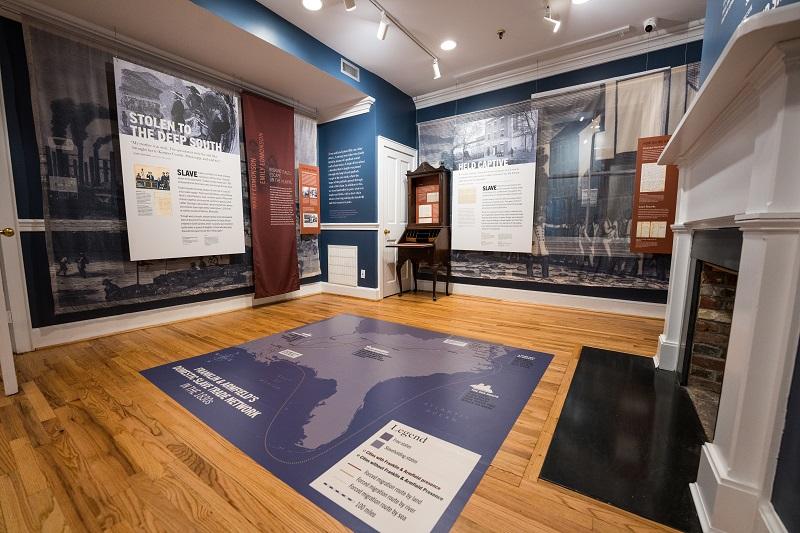
History of 1315 Duke Street
History of 1315 Duke Street
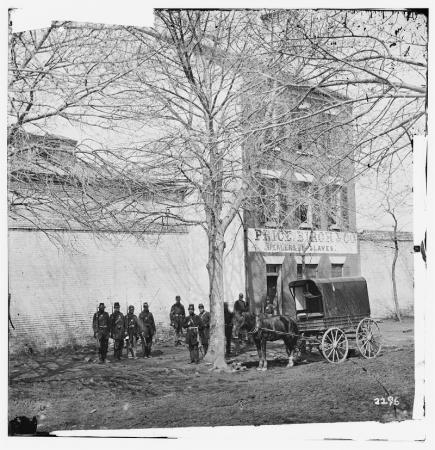
The Franklin and Armfield Slave Pen at 1315 Duke Street was one of the largest slave trading companies in the country and is listed on the National Register of Historic Places.
The three-story brick building with mansard roof was built as the residence of Robert Young, Brigadier General of the second Militia of the District of Columbia. By 1828, it was leased by Isaac Franklin and John Armfield and used as a "Negro Jail" or slave pen for slaves being shipped from Northern Virginia to Louisiana. Franklin and Armfield were active until 1836, exporting over 3,750 slaves to cotton and sugar plantations in the Deep South. Later, other firms continued trading in slaves here. A sign seen in Civil War period photographs has the name of Price, Birch & Co. During the Civil War the building and its surrounding site were used as a military prison for deserters, the L'Ouverture Hospital for black soldiers and the barrack for contraband-slaves who fled the confederate states and sought refuge with Union troops.
Building and Property History

Summary
The following building and property history is centered on the structure currently at 1315 Duke Street in the City of Alexandria, Virginia and the infamous slave jail complex that once stood there. This four-story brick building, while heavily modified, is the only portion of this slave jail complex still standing.
Built c. 1812 on what was then the edge of town, 1315 Duke Street originally consisted of the main block of the current structure, which was then only three stories tall, and possibly the original kitchen wing to the rear, and was the home of Brigadier General Robert Young. Between 1828 and 1861, this building served as the offices and headquarters of a series of slave-trading businesses, including Franklin & Armfield, one of the largest domestic slave trading firms in the country between 1828 and 1837. They converted the residence into a massive slave jail complex that encompassed half of the block by adding a pair of yards enclosed by high brick walls, one to either side of the main block, and fenced in the remainder of the property. It was used until the Civil War by a series of subsequent businesses also engaged in human trafficking, first under George Kephart, formerly an agent for Isaac Franklin and John Armfield, and then by C. M. Price and John C. Cook. On May 24, 1861, the Union Army liberated the slave jail complex when they entered Alexandria the day after Virginians voted to adopt the State’s ordinance of secession.
During the Civil War, the Union Army used the site as a military prison, slightly modifying the jail primarily to confine Union soldiers accused of various rule infractions and to accommodate the adjacent L’Ouverture Hospital and Contrabands Barracks. Shortly after the war, the majority of the complex was demolished by a private developer building new townhouses, save for the original residence and rear wing consisting of its original kitchen and passageway. The building was rented as a boarding house or apartments throughout the late 19th and for much of the 20th century, with a major renovation in the first decade of the 20th century seeing an additional story added to the front and back of the building and new windows. Another major renovation of the structure occurred in 1984 when the rear yard was enclosed within an addition to the building and the interior of 1315 Duke Street was reconfigured from apartments into office space. The Northern Virginia Urban League purchased the property in 1997and 23 years later, sold 1315 Duke Street to the City of Alexandria.
The following building history narrative for 1315 Duke Street represents our current and best understanding of the history of the building and the property and has been drawn from an array of primary and secondary sources. These include deeds, newspapers, censuses, City tax lists, published narratives, maps, historic photographs, the 1987 archaeology report of excavations at 1315 Duke Street by Engineering-Science, Inc. (Artemel et al., 1987), Michael Ridgeway’s 1976 thesis A Peculiar Business: Slave Trading in Alexandria, Virginia, 1825-1861, Robert Gudmestad’s 1999 dissertation A Troublesome Commerce: The Interstate Slave Trade, 1808- 1840, and Calvin Schermerhorn’s 2015 book The Business of Slavery and the Rise of American Capitalism, 1815-1860. A forthcoming book by Joshua Rothman, The Ledger and the Chain: How Domestic Slave Traders Shaped America, and an upcoming expansion of the Slave Voyages database (slavevoyages.org) to include the domestic slave trade will certainly further refine this history. This document represents a first attempt to pull together existing material that documents the site as well as additional historic, archival, and archaeological research not presented in these sources. From this analysis, there are issues raised in the following pages that are contradictory, not well-documented, or unclear from the evidence so far uncovered. Where possible, these uncertainties have been identified and future research has been recommended. It is hoped that any gaps or deficiencies in this document serve as a roadmap future research.
Out of necessity, this report is not comprehensive. While related, it does not focus on the domestic slave trade in either Alexandria or in Washington, D.C. It does not address the contours of urban or agricultural slavery in the City. It largely omits biographical sketches of the individuals mentioned here and it does not include a discussion of surviving ledgers, letters, or other records like shipping manifests that highlight the scope and scale of the activities of the businesses operating out of 1315 Duke Street beyond that which is relevant to a discussion of the physical building and property. These are relevant topics to the history of 1315 Duke Street but are planned to be addressed in separate research products to be produced in the future, including a more detailed architectural analysis of the current structure and a reanalysis of the previous archaeology conducted at the site.
Full Report
Building and Property History, 1315 Duke Street. Benjamin Skolnik, Office of Historic Alexandria (2021)
- Appendix A: 1315 Duke Street Chain of Title, Prepared by Sue Shuman, Office of Historic Alexandria
- Appendix B: Conjectural Plans
- Appendix C: 1984 Renovation Plans
- Appendix D: 2005 Renovation Plans
- Appendix E: 2020 City of Alexandria Renovation Plans
Chain of Title
Chain of Title for 1315 Duke Street
A timeline of the Chain of Title for 1315 Duke Street is followed by details of ownership. Also view a Chain of Title Narrative for more information.
Biographies
Read biographies for three owners of 1315 Duke Street.
Robert Young (1812-1824) built the three story brick house, and lived there with his family from 1819 until 1824.
Isaac Franklin and John Armfield (1828-1837) were the first to use the property as a slave pen.
Historic Structure Report
A Historic Structure Report (HSR) provides documentary, graphic, and physical information about a property's history and existing condition. The HRS was finalized in 2023.
Read the Historic Structure Report and a report summary, view the presentation slideshow, or watch a video to learn more.
National Register of Historic Places
The site is listed on the National Register of Historic Places as the Franklin and Armfield Office. Read the nomination form on the Virginia Department of Historic Resources website.
Watch Videos
Exposing the Alexandria Slave Pen: Historic Photographs, Engravings and Illustrations
Exposing the Alexandria Slave Pen: Historical Photographs, Engravings, and Illustrations of 1315 Duke Street was presented by City of Alexandria Archaeologist Dr. Ben Skolnik on Monday, February 13, 2023. Now the Freedom House Museum, 1315 Duke Street was once the location where several 19th-century dealers trafficked enslaved men, women, and children to the Deep South. Dr. Skolnik looks at period photographs and illustrations of the building and shares what they tell us about the building and the businesses which operated from 1315 Duke Street.
Ideologies in Tension and Moments of Change The Slave Jail at 1315 Duke Street
Alexandria Archaeology's Dr. Benjamin Skolnik and University of Maryland graduate student Samantha Lee briefly discuss how the Franklin & Armfield slave jail complex at the 1300 block of Duke Street facilitated a fundamental change in America’s domestic slave trade.
Building a Structure's History
Learn more about the detective work behind reconstructing 1315 Duke Street's history. Get a video sneak peak of how Dr. Ben Skolnik combed through images, documents, + the archaeological record to better understand the development of the site.
The Ledger and the Chain: How Domestic Slave Traders Shaped America
Historian Joshua D. Rothman presents his new book, The Ledger and the Chain. Rothman recounts the shocking story of the domestic slave trade by tracing the lives and careers of Isaac Franklin, John Armfield, and Rice Ballard, who built the largest and most powerful slave-trading operation in American history. Franklin & Armfield was headquartered in 1315 Duke Street, now the Freedom House Museum. This lecture was recorded May 11, 2021 and was sponsored by the Alexandria Community Remembrance Project.
History and Research: Primary Sources
Introduction
Research into the history of this building and the people who were trafficked through it is ongoing. Below is a sampling of how researchers are using primary sources to piece together the stories of those impacted by the domestic slave trade.
The 1830 Census
The 1830 Census
The 1830 Census enumerates the enslaved people held at the Franklin & Armfield slave pen.
Tracking the Brig Uncas in Historic Newspapers
Tracking the Brig Uncas in Historic Newspapers
Franklin & Armfield's two ships, the Uncas and the Tribune, carried enslaved people to New Orleans and goods like sugar back to Alexandria.
Burdett and William Henry Washington
Burdett and William Henry Washington
William Henry Washington, a ten-year old enslaved boy, sailed to New Orleans on the Uncas, as his father Burdett worked to free him.
Archaeological Site Reports
The Alexandria Slave Pen, 1315 Duke Street (Freedom House Museum)
Artemel, Janice G., Elizabeth A. Crowell and Jeff Parker. The Alexandria Slave Pen: The Archaeology of Urban Captivity. Engineering-Science, Inc., Washington, D.C., 1987 (Archaeological Site Report, 44AX75)
Traum, Sarah, Joseph Balicki and Brian Corle. A Documentary Study, Archeological Evaluation and Resource Management Plan for 1323 Duke Street, Alexandria, Virginia. John Milner Associates, Inc., Alexandria, VA., 2007
The Bruin Slave Jail, 1701 Duke Street
Kraus, Lisa, John Bedell and Charles LeeDecker. Archaeology of the Bruin Slave Jail (Site 44AX0172). The Louis Berger Group, Inc., Washington, D.C., 2010. Public Summary (Archaeological Site Report, 44AX172)
More Information
- Alexandria's African American Community: Online Resources
- "A Loathsome Prison:” Slave Trading in Antebellum Alexandria, a lesson plan for teachers.
- Slaves in the Alexandria Jail, 1861. This article, from the National Republican of January 20, 1862, was taken from a letter addressed to Massachusetts’ anti-slavery Senator Henry Wilson. It expresses outrage at the poor conditions and inhumanity of treatment of slaves in the Alexandria Jail, even under federal occupation. (Courtesy, Friends of Freedmen’s Cemetery)
19th Century Images
These images of the Slave Pen include an anti-slavery broadside from 1836 and photographs taken during the Civil War, 1861-1865, when the property was used by the Union Army as a jail.
Learn more about Photographs of 1315 Duke Street:
“Photographic Presentments of Them Will be Accepted by Posterity with an Undoubting Faith ” Correcting Two Civil War-Era Photographs of Alexandria, Virginia Attributed to William R. Pywell and Published in Gardner’s Photographic Sketch Book of the War.(1866). Benjamin A. Skolnik, Alexandria Chronicle, Winter 2023-2024. Alexandria Historical Society.
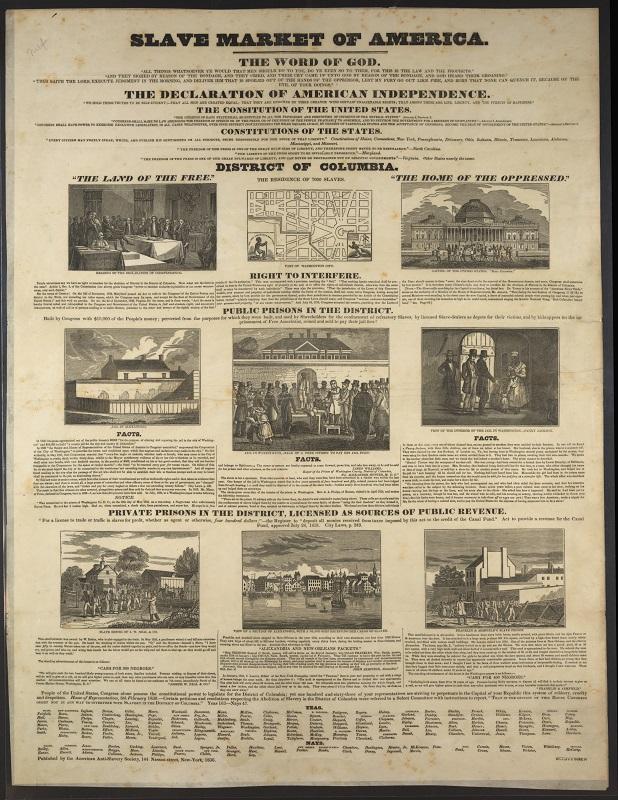




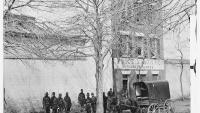










2018670631.

2006683273; Original negative in National Archives.



20th Century Images
See an image from 1929, an aerial view from 1937, an image of Annie B. Rose giving a tour in the 1970s, and images from 1984 when archaeological fieldwork took place prior to renovation of the building.

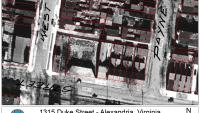














21st Century Images: Freedom House Museum 2009-2018
This exhibit was created in the basement of 1315 Duke Street on behalf of the building's inhabitants, the Northern Virginia Urban League (NVUL). The current exhibit, which opened in 2022, is on the upper floors of the building because of the steep and narrow staircase and water issues in the basement.


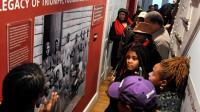

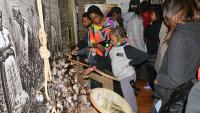











21st Century Images: Freedom House Museum Reopens 2022
The newly reopened Freedom House Museum. Photos by Chris Cruz for Visit Alexandria.
















